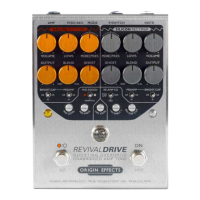7
in volume to meet the highs until all frequencies are as loud as each other and the pot
effectively bypasses the cap.
BRIGHT CAP COMPENSATION
Bright caps are relevant to another feature of the RevivalDRIVE – the BRI-CAP CUT
filter control in the RE-AMP EQ. This low-pass filter is designed to compensate for the
presence of a bright cap in the guitar amp you’re plugged into, something that can often
prove problematic.
Many vintage (and vintage-style) amps make use of bright caps. The Blackface Fender
Deluxe, the Marshall JTM45 and the Vox AC30’s “Brilliant” channel are just three
examples. These amps were not designed with overdrive pedals in mind – if you wanted
overdrive, you simply turned the amp up! Today, when many players would rather use an
overdrive pedal into a clean-ish amp to create a secondary, overdriven sound, the bright
cap ends up boosting and accentuating the high-frequency harmonics in the overdrive
pedal’s output. This tends to lead to a harsh, unnatural and raspy tone, making even the
best-sounding drive pedal sound like a wasp in a jam jar.
To compensate for this increased high-frequency emphasis, the BRI-CAP CUT filter
progressively rolls off highs from the RevivalDRIVE’s output so you can adapt it to
perfectly fit the frequency response of your chosen amp.
LOW-FREQUENCY DISTORTION
Another crucial aspect of amplifier design is the treatment of low frequencies. Allowing the
bass end to distort yields a thicker, more full-blooded driven sound, but with the risk of
turning your sound to mush. Try cranking up a Tweed Fender amp or a Marshall JTM45
with the bass on full – the low frequencies push the power stage into severe distortion, to
the extent that the amplifier is sometimes unable to fully recover between notes.
Conversely, restricting low-frequency distortion will produce a tighter, more defined
overdrive with immediate note recovery. A more well-behaved sound, in other words,
though potentially too polite for some – it’s all a matter of taste!
Happily, the LOWS knob on the RevivalDRIVE will let you experiment with this aspect of
amp design so you can find your ideal setting. Turned fully clockwise, the response is
modelled on the JTM45 and, true to the original, it has the potential to get pretty ugly!
Turned fully counter-clockwise, the LOWS control imitates a Marshall Super Lead or the
“Brilliant” channel on a Vox AC30. The low frequencies stay almost completely clean,
delivering a lean and limber overdrive sound. In between these two extremes, the LOWS
control reproduces the characteristic response of a Blackface-era Fender amp.

